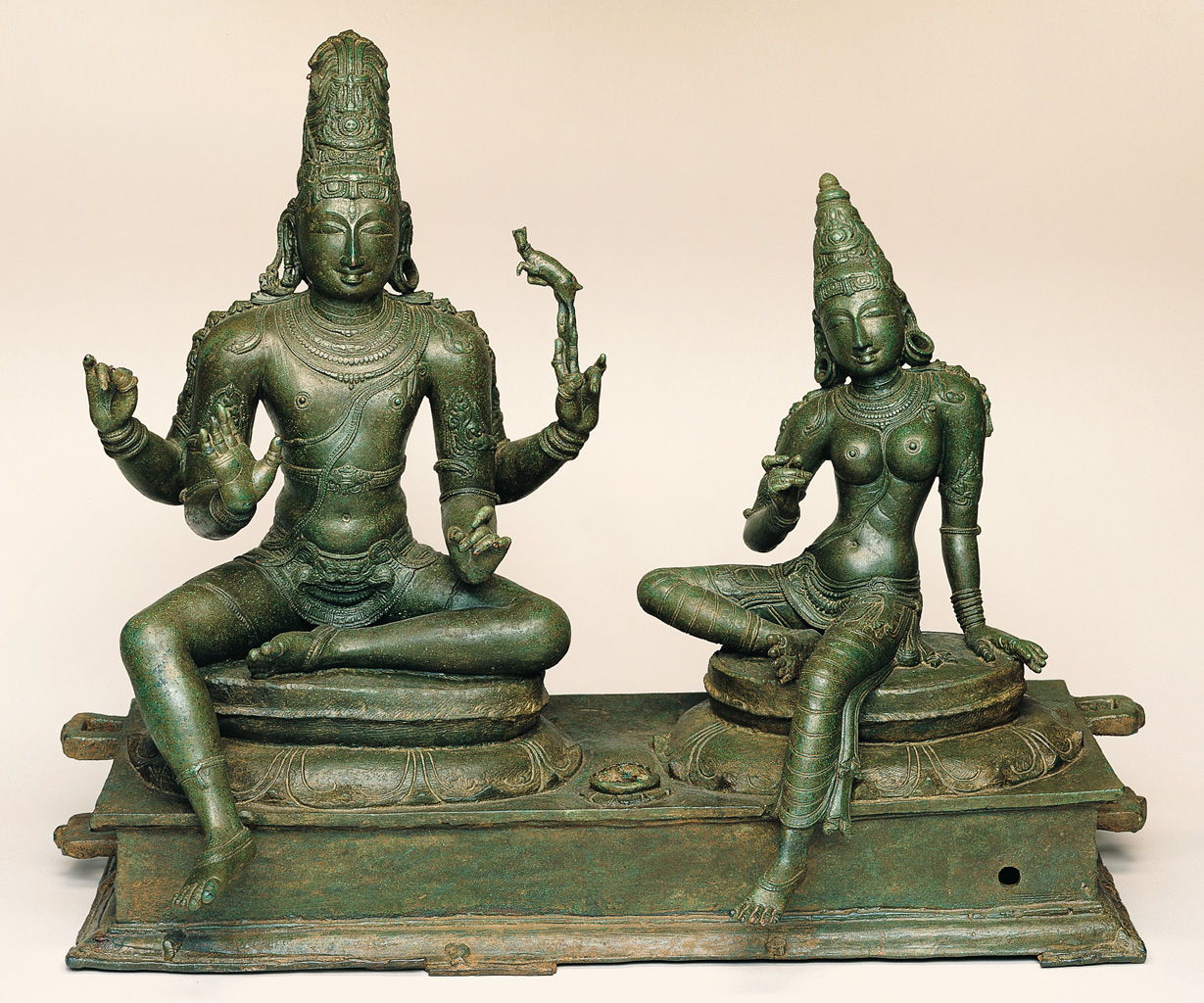Home / Alamkara: Dressing the God
Alamkara: Dressing the God
During non-festival times today, the processional bronzes of a Shaiva temple are typically placed in a mandapa, a pillared hall adjacent to the sanctum, where they may be visited by worshipers. They are often displayed with little ornamentation, in contrast to their elaborate appearance during festival events.
In preparation for their public appearances, the deities are ritually undressed, bathed, and then dressed again. The dressing ritual (during which photography is not permitted) is known in Sanskrit as alamkara. The term is derived from alam, meaning “sufficient,” and the verb kr, meaning “to make.” As the name suggests, alamkara is not superfluous embellishment. It completes and empowers the icons with properties, such as grace, beauty, and decorum, which in turn increase their efficacy or spiritual power. Alamkara further serves to articulate the sacredness and high status of the images. At the same time, it prepares them for darshana, the worshiping rite of seeing and being seen by the deity.
Deities are typically adorned in newly commissioned silk clothes, jewelry, fresh flower garlands, cosmetics, and perfumes. Like the bronzes themselves, these articles of costume are commissioned as acts of religious devotion. Jewelry and weaponry suggest regal affiliations and often include crowns, bracelets, armbands, necklaces, breastplates, rings, and earrings—typically inlaid with gold, silver, or precious stones. Appropriate markings adorn the forehead, such as the Shaiva marking of three horizontal stripes of white ash, which is also used to mark the foreheads of worshipers. The lifelike manner in which the deity’s bodies are embellished reveals the intimate relationship between the image, the divine, and the worshiper.
The lavish adornment of bronzes for festival processions was similarly practiced during the Chola period. The exquisitely rendered facial and costume details (created through the lost-wax technique) were largely concealed during the dressing process. Vertical prongs on the bases of numerous Chola bronzes originally supported a prabha, or aureole, which customarily framed the deity during processions. Held high, the deity appeared to observers as an honored and living presence, elaborately haloed and adorned.
Today, a portable bronze image of a standing Ganesha typically commences festival processions, including that of the Brahmotsava festival, pictured in the photographs on display in this gallery. In this capacity Ganesha serves as the deity of auspicious beginnings, leading the festival prior to the appearance of the main deity, Shiva, and the rest of his entourage. The Brahmotsava procession includes five primary sets of images: Shiva as Somaskanda; Shiva’s consort Uma; their son Skanda (Murukan) with his two wives Valli and Devayani; Ganesha; and Saint Chandesha. The exquisite detailing and
sensual grace of Ganesha’s sculpted figure suggest that he was a major deity during the Chola period.
Although Chola bronze icons were lavishly embellished for processions with silk garments, jewels, and garlands, the metal surfaces themselves were adorned with finely rendered costume details. In this image, a bejeweled Shiva (on the left) is dressed in a short dhoti, and his matted hair is arranged in a royal crown-like form. He wears two kinds of earrings—an aquatic makara-shaped earring on his right ear and a large circular ring on his left—which symbolize his dual nature, comprising male and female aspects respectively. At the back of both his and Uma’s heads is a small halo-like wheel, or siraschakra, covering the headband knot. This ornament typically adorns all Chola bronze deities and is absent only when the knot itself is elaborately rendered, such as in the tenth-century image of Shiva Nataraja in the second gallery of this exhibition.
In Shaiva temples today, an enshrined stone image of Shiva’s mount—the bull, or vrsa, commonly referred to as Nandi (“joyous one”)—is typically placed in front of the temple sanctum facing the sacred center as a guardian figure. Chola period bronze processional images of the bull, however, are rare, suggesting that he was more commonly fashioned out of perishable material, such as wood, for festival events. In this hollow-cast bronze, Shiva’s bull sits serenely upright on a double-lotus pedestal above a rectangular base pierced with holes that would have been used to fasten the sculpture to a vehicle during processions. He is adorned with multi-stranded garlands of bells around his neck, metal covers on his horns, an elaborate saddlecloth and harness, and jeweled anklets—all of which evoke his royal status.
Ganesha
Chola period, 11th century
Copper alloy
H. 21 1/4 x W. 12 x D. 10 7/8 in. (54 x 30.5 x 27.6 cm)
Asia Society, New York: Mr. and Mrs. John D. Rockefeller 3rd Collection, 1979.26
EnlargeShiva as Somaskanda (with Uma and Skanda)
Chola period, late 12th century
Copper alloy
H. 19 x W. 23 3/4 x D. 11 in. (48.3 x 60.3 x 27.9 cm)
Asia Society, New York: Mr. and Mrs. John D. Rockefeller 3rd Collection, 1979.28
EnlargeShiva’s Bull
Chola period, ca. 1200
Copper alloy
H. 20 1/4 x W. 20 1/2 x D. 13 1/4 in. (51.4 x 52.1 x 34 cm)
Asia Society, New York: Mr. and Mrs. John D. Rockefeller 3rd Collection, 1979.30
Enlarge




 Share
Share